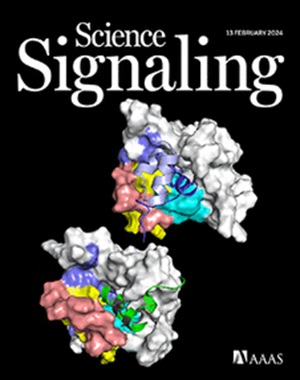Structural robustness and temporal vulnerability of the starvation-responsive metabolic network in healthy and obese mouse liver
IF 6.6
1区 生物学
Q1 BIOCHEMISTRY & MOLECULAR BIOLOGY
引用次数: 0
Abstract
Adaptation to starvation is a multimolecular and temporally ordered process. We sought to elucidate how the healthy liver regulates various molecules in a temporally ordered manner during starvation and how obesity disrupts this process. We used multiomic data collected from the plasma and livers of wild-type and leptin-deficient obese (ob/ob) mice at multiple time points during starvation to construct a starvation-responsive metabolic network that included responsive molecules and their regulatory relationships. Analysis of the network structure showed that in wild-type mice, the key molecules for energy homeostasis, ATP and AMP, acted as hub molecules to regulate various metabolic reactions in the network. Although neither ATP nor AMP was responsive to starvation in ob/ob mice, the structural properties of the network were maintained. In wild-type mice, the molecules in the network were temporally ordered through metabolic processes coordinated by hub molecules, including ATP and AMP, and were positively or negatively coregulated. By contrast, both temporal order and coregulation were disrupted in ob/ob mice. These results suggest that the metabolic network that responds to starvation was structurally robust but temporally disrupted by the obesity-associated loss of responsiveness of the hub molecules. In addition, we propose how obesity alters the response to intermittent fasting.
健康和肥胖小鼠肝脏中饥饿反应代谢网络的结构稳健性和时间脆弱性
对饥饿的适应是一个多分子和时间有序的过程。我们试图阐明健康的肝脏如何在饥饿期间以一种暂时有序的方式调节各种分子,以及肥胖如何破坏这一过程。我们利用在饥饿期间多个时间点从野生型和瘦素缺乏型肥胖(ob/ob)小鼠的血浆和肝脏中收集的多组学数据,构建了一个包括响应分子及其调控关系的饥饿响应代谢网络。对网络结构的分析表明,在野生型小鼠中,能量稳态的关键分子ATP和AMP作为中枢分子调节网络中的各种代谢反应。虽然在ob/ob小鼠中,ATP和AMP对饥饿都没有反应,但网络的结构特性得以维持。在野生型小鼠中,网络中的分子通过中枢分子(包括ATP和AMP)协调的代谢过程暂时有序,并受到正向或负向的协同调节。相比之下,ob/ob小鼠的时间秩序和协同调节都被破坏了。这些结果表明,对饥饿作出反应的代谢网络在结构上是健全的,但由于肥胖相关的中枢分子反应性丧失而暂时中断。此外,我们提出肥胖如何改变对间歇性禁食的反应。
本文章由计算机程序翻译,如有差异,请以英文原文为准。
求助全文
约1分钟内获得全文
求助全文
来源期刊

Science Signaling
BIOCHEMISTRY & MOLECULAR BIOLOGY-CELL BIOLOGY
CiteScore
9.50
自引率
0.00%
发文量
148
审稿时长
3-8 weeks
期刊介绍:
"Science Signaling" is a reputable, peer-reviewed journal dedicated to the exploration of cell communication mechanisms, offering a comprehensive view of the intricate processes that govern cellular regulation. This journal, published weekly online by the American Association for the Advancement of Science (AAAS), is a go-to resource for the latest research in cell signaling and its various facets.
The journal's scope encompasses a broad range of topics, including the study of signaling networks, synthetic biology, systems biology, and the application of these findings in drug discovery. It also delves into the computational and modeling aspects of regulatory pathways, providing insights into how cells communicate and respond to their environment.
In addition to publishing full-length articles that report on groundbreaking research, "Science Signaling" also features reviews that synthesize current knowledge in the field, focus articles that highlight specific areas of interest, and editor-written highlights that draw attention to particularly significant studies. This mix of content ensures that the journal serves as a valuable resource for both researchers and professionals looking to stay abreast of the latest advancements in cell communication science.
 求助内容:
求助内容: 应助结果提醒方式:
应助结果提醒方式:


